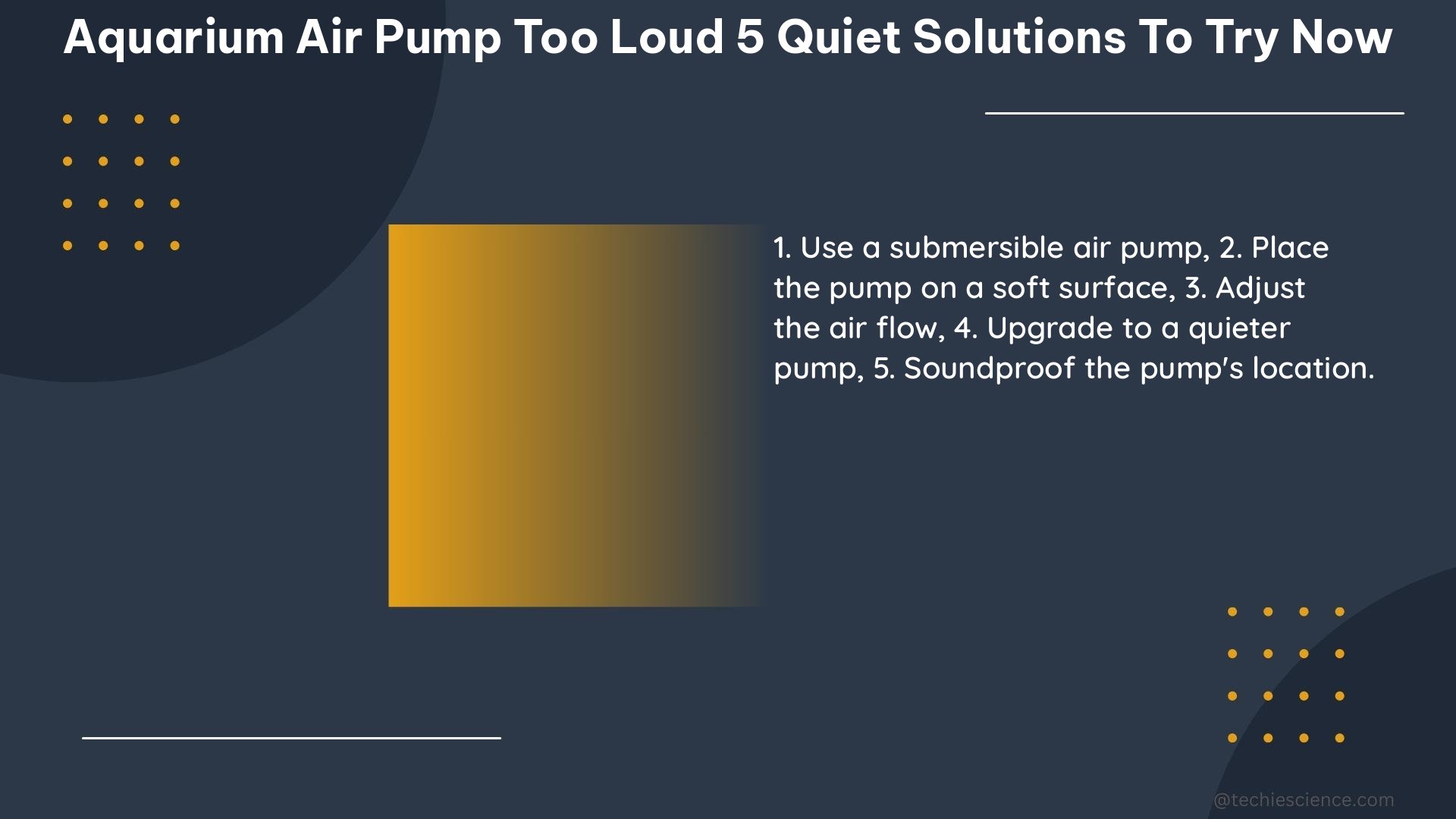Are you tired of the constant humming and buzzing of your aquarium air pump? Dealing with a noisy air pump can be a frustrating experience for any aquarium hobbyist. However, there are several effective solutions you can try to reduce the noise and create a more peaceful environment for your aquatic friends.
In this comprehensive guide, we’ll explore five quiet solutions to address the problem of a loud aquarium air pump, along with their technical specifications and step-by-step DIY approaches. Whether you’re a beginner or an experienced aquarist, these solutions will help you achieve a quieter and more enjoyable aquarium setup.
Solution 1: Place the Pump on a Soft Cushion
One of the easiest and most effective ways to reduce the noise from your aquarium air pump is to place it on a soft cushion. This simple solution can help to absorb the vibrations and muffle the sound, creating a more peaceful environment for your aquarium.
Technical Specifications:
- Soft Cushion Material: Towel, foam, or other soft, non-vibrating materials
- Cushion Thickness: Approximately 1-2 inches (2.5-5 cm) thick
- Cushion Size: Slightly larger than the base of the air pump
To implement this solution, follow these steps:
- Identify a suitable soft cushion material, such as a small towel or a block of foam.
- Place the cushion on a stable, non-vibrating surface, such as a wooden or plastic base.
- Carefully place the air pump on top of the cushion, ensuring it is centered and secure.
- Test the air pump to ensure it is functioning properly and the noise has been reduced.
Solution 2: Rest the Pump on a Solid Surface

Another effective solution is to rest the air pump on a solid, non-vibrating surface. This can help to reduce the noise caused by the pump’s vibrations against a surface.
Technical Specifications:
- Solid Surface Material: Wood, plastic, or other non-vibrating materials
- Surface Thickness: Minimum 1/4 inch (6 mm) thick
- Surface Size: Slightly larger than the base of the air pump
To implement this solution, follow these steps:
- Identify a suitable solid surface, such as a wooden or plastic base.
- Place the solid surface on a stable, non-vibrating location, such as a table or shelf.
- Carefully place the air pump on top of the solid surface, ensuring it is centered and secure.
- Test the air pump to ensure it is functioning properly and the noise has been reduced.
Solution 3: Reduce Any Resistance to the Pump
Resistance in the aquarium system can contribute to the noise generated by the air pump. Cleaning any devices or decorations connected to the air pump can help to reduce this resistance and lower the overall noise level.
Technical Specifications:
- Cleaning Supplies: Soft brush, sponge, or other gentle cleaning tools
- Cleaning Frequency: Weekly or as needed, depending on the aquarium setup
To implement this solution, follow these steps:
- Identify any devices or decorations connected to the air pump, such as air stones, tubing, or diffusers.
- Carefully remove these items from the aquarium and clean them thoroughly using a soft brush or sponge.
- Rinse the cleaned items and ensure they are free of any debris or obstructions.
- Reattach the cleaned items to the air pump and test the system to ensure the noise has been reduced.
Solution 4: Hang the Pump by the Power Cord
Hanging the air pump by its power cord can help to prevent it from touching or vibrating against any surfaces, which can contribute to the overall noise level.
Technical Specifications:
- Hanging Tools: Hooks, elastic bands, or other secure hanging devices
- Hanging Surface: Wall, ceiling, or other stable, non-vibrating surfaces
To implement this solution, follow these steps:
- Identify a suitable location to hang the air pump, such as a wall or ceiling.
- Securely attach the hanging tools (e.g., hooks or elastic bands) to the hanging surface.
- Carefully suspend the air pump by its power cord, ensuring it is not touching any surfaces.
- Test the air pump to ensure it is functioning properly and the noise has been reduced.
Solution 5: Replace the Pump with a Quieter One
If the above solutions do not provide the desired noise reduction, you may consider replacing your current air pump with a quieter model, such as a USB nano air pump.
Technical Specifications:
- New Air Pump Model: USB nano air pump or other quieter models
- Power Source: USB or other power sources, depending on the new pump’s requirements
To implement this solution, follow these steps:
- Research and identify a quieter air pump model that meets your aquarium’s requirements.
- Carefully disconnect the old air pump and remove it from the aquarium setup.
- Install the new air pump according to the manufacturer’s instructions, ensuring proper connections and placement.
- Test the new air pump to ensure it is functioning properly and the noise level has been significantly reduced.
Remember, when implementing these solutions, it’s essential to follow the technical specifications and safety guidelines to ensure the proper and safe operation of your aquarium air pump.
References:
- Silence Your Air Pump Like THIS – YouTube
- Anyone have tips for quieting a noisy air pump? : r/Aquariums – Reddit
- How do I make my air pump quieter? – Aquarium Co-Op
- Air Pump is so loud! – FishLore
- My Air Pump Is Too Loud , Anyone Can recommend quiet one – Aquarium Forum
